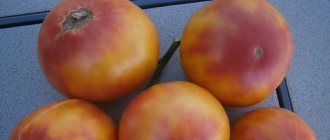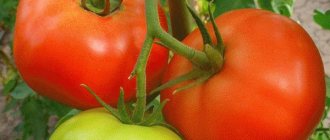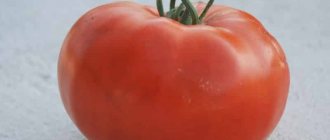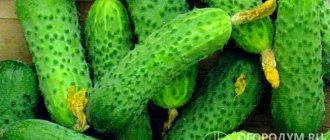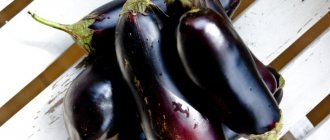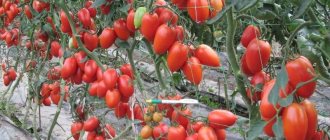Description of the variety
The variety is suitable for growing in greenhouses and open ground. The bushes are determinate, i.e. limited in growth, which greatly facilitates the care of the crop. Tomato Family F1 is an early ripening variety, the first harvest is harvested 105-115 days from planting.
Over a short period of ripening, the risk of infection is significantly reduced, which is good for yield.
Distinctive features
The bushes are compact, maximum height is about 100-110 cm. The leaves look like potato leaves and have the same dark green color. The stem and root system are developed and powerful. Inflorescences are racemose, small. Each cluster produces about 5 large red tomatoes.
Characteristics of tomatoes and yield
The weight of one tomato is about 200 g. The color is rich, the flesh is juicy and fleshy. The hybrid's peel is dense, which allows the vegetables to be stored for a long time without cracking. There are many seed chambers. The taste is sweet and sour with a classic aroma.
With quality care, one bush produces from 4 to 7 kg of ripe and tasty vegetables. In a greenhouse with 1 sq. m harvest about 19 kg.
Interesting! In the Middle Ages, a scientist named John Gerard said in his writings that tomatoes and its leaves were poisonous. Gerard categorically forbade eating vegetables. The scientist’s opinion was so significant for the British that until the 18th century people did not eat tomatoes. And he himself grew the crop in his garden only for scientific purposes. It is noteworthy that at the same time, tomatoes were eaten in Italy and Portugal, which John Gerard knew about.
Pest and disease control
Possessing almost perfect immunity, the Family tomato does not need to be treated with special agents against fungal and infectious diseases. For preventive purposes, it is only recommended to ventilate the greenhouse to remove excess moisture. It is best to ventilate the greenhouse during the daytime to eliminate the possibility of overcooling the plantings.
To control pests, use special insecticides or folk remedies - copper sulfate or soapy water. When grown in open ground, Colorado potato beetles are collected by hand, trying to completely remove their colonies from the green part of the plant.
How to grow seedlings
To get a good harvest, gardeners recommend planting tomatoes in seedlings. Although this takes more time and effort, it will be easier for the plant to take root in the garden plot. Especially when it comes to regions with unpredictable climatic conditions.
Seed preparation
You can purchase Family Tomato seeds at any gardening store or order by mail. On the bags, the manufacturer indicates recommendations for planting and growing.
First, inspect the seeds for defects. If individual specimens are of unusual color or shape, do not plant them. Be sure to disinfect the rest of the material.
They do this in several ways:
- lay it out in the sun for 5-7 days, for example, on a balcony or on a bench near the house;
- soak for 24 hours in a solution of potassium permanganate, for convenience, first placing the seeds in a fabric bag;
- Soak overnight in aloe juice.
Disinfection will destroy dangerous microbes on the surface of the seeds, which will subsequently ensure rapid germination and a good harvest. Afterwards it is necessary to germinate the seed material. Take a damp cotton pad, place the seeds in it and put the disc in a plastic bag or plate. In this form, the seeds are stored for 4-7 days. Germination helps the plant develop immunity to diseases and parasites.
Container and soil
Most gardeners use ready-made soil mixtures for seedlings. Firstly, they are pre-disinfected by the manufacturer and do not contain pathogens. Secondly, such soil is enriched with vitamins and minerals necessary for the plant. Purchasing land will not be difficult; on average, 10 liters costs about 150 rubles.
Plant seedlings in any clean and dry container - cardboard milk cartons, plastic cups, flower pots, and so on. Especially recently, peat pots or tablets have become popular. They are made from environmentally friendly materials, which means they are absolutely safe for both plants and humans. Such containers are affordable and easy to use. Plus, peat containers retain moisture well, which is important for a hybrid.
Landing
Prepare seedlings 50 days before planting in the garden. To do this, pour the soil into a container, make grooves 2 cm deep in it. The distance between the grooves should be at least 15 cm. Place the seeds in the holes and sprinkle the soil on top. Don't forget to water the seedlings with warm water. To speed up growth, stretch the film or place glass on top.
Growing and care
The optimal temperature for growing seedlings is about 22 degrees;
as soon as the first shoots appear, we recommend reducing it to 18. This will speed up the formation of flower clusters. The best place for growing is a bright window. However, make sure there are no drafts. As soon as half of the seeds germinate, remove the film.
Water the seedlings only with warm filtered water. For ease of watering, use a pipette or syringe. After 5 days, as soon as all the seeds hatch, organize feeding with calcium nitrate.
In the future, feed the tomatoes every 10 days. To do this, use an ash solution, liquid bird droppings, or superphosphate.
Important! An effective remedy for increasing plant immunity is Bordeaux mixture. You can buy a ready-made mixture in the store or make it yourself. Spraying from a spray bottle rids seedlings and soil of harmful microorganisms and improves the development of the root system.
Agricultural technology of culture
Tomato Slot: characteristics and description of the variety
Seeds for seedlings are sown in March-April. It is better not to sow too early, so that the seedlings do not subsequently outgrow before being planted in the greenhouse. This has a bad effect on productivity.
The substrate for planting can be purchased at a specialized store or made independently; it consists of:
- 6.5 kg of peat;
- 2.5 kg of sawdust;
- 1 kg of river sand;
- 25 g lime;
- 300 ml water.
So that the elements have time to interact with each other, they should be prepared in advance, at least 2 weeks in advance. Before planting, the soil is disinfected with preparations or methods of steaming and calcination.
It is necessary to disinfect the soil
Microelements are added in dissolved form before planting. The prepared soil is poured into a separate box.
Seeds of hybrid tomatoes are planted in separate boxes from varietal tomatoes due to different germination times. For planting, grooves are made in the ground, about 1 cm deep, with a distance of 4 cm between the lines. They are sown at a distance of 1-1.5 cm and covered with soil, pressed lightly. Do not water the soil after planting. Cover the planting boxes with film to create the necessary conditions: heat and humidity. For germination, the soil temperature should be 25-27°C. Sudden changes in temperature are unacceptable.
Important information! Boxes should not be placed on a cold windowsill; they should be placed under a bedding made of special materials or a warm rug. Shelves may be a good option.
You can plant each seed in one peat cup or in special cassettes.
After 7-10 days, shoots appear. The covering film is removed only after more than half of the seedlings have sprouted, so as not to harm the rest by lowering the temperature. After all the seeds have sprouted, the cover is removed, the box is placed in a bright place, and for the next 4 days the illumination of the sprouts should be around the clock. This can be done using specially equipped lighting. The temperature is maintained at +16°C for one week. After this, they are grown at a daytime temperature of +22°C, and a night temperature of +18°C, with 12 hours of lighting during the day.
Home care for seedlings may include careful watering using a syringe without a needle, avoiding excess moisture, which leads to root rot.
Picking - transplanting seedlings into a separate, more spacious container, for example, into 0.5 ml cups. This transplant is done when several true leaves appear. The container is filled with the same soil in which the sowing was done. For a plant, such a transplant is stressful; in order to improve the survival process, the air temperature is increased for several days.
Growing in a greenhouse
The greenhouse for seedlings is prepared in early May; tomato seedlings are planted 50 days after planting the seeds. The soil is filled with vermicompost.
Low-growing, early-ripening hybrids are planted in the ground according to a 40*70 cm pattern, where 40 cm is the distance between holes, and 70 cm is the distance between rows, planted in parallel lines.
When the plant reaches a height of 40 cm, it is carefully tied above the fourth leaf.
Stepchildren of the Family tomato, 3-5 cm in size, are removed throughout the season. Stepchildren are removed by breaking the shoot so that the juice does not fall on the gardener’s hand, in order to avoid infection of other plants if one of them turns out to be unhealthy. Pinching does not affect the yield, but enlarges the fruits due to the supply of nutrients to them, which could be taken up by the shoots. The absence of extra stepsons is also useful because the less dense plant is well ventilated.
Important! You should not pick off all the leaves or only at the very end of the growing season, because they perform an important function of delivering nutrients and raising juices throughout the plant.
Ventilation is necessary for the culture so that condensation does not form, and a humid environment does not contribute to the formation of pathogens that can lead to various diseases. In order not to tear off the fertile brush instead of the stepson, you should know the differences between them. So, the brush with the future harvest begins to grow from the stem, and the stepson - from the axil of the leaf; leaves begin to be visible on the small stepson, and the rudiments of flowers begin to appear on the brush.
After the fruits are formed, the leaves below the inflorescence are removed. Leaves are also not allowed to touch the ground.
Tomatoes grow and develop favorably in a greenhouse at a soil temperature of about 20°C, and an air temperature in sunny weather of 23-30°C. The plant does not tolerate temperatures above these values.
In addition to light and heat, Family tomatoes require active, abundant, even watering. In one watering, the soil should be spilled onto the spade bayonet, but the plant should also not be overwatered, so that the root system does not suffocate and various types of fungi do not form. Water with warm water at sunset. In determinate growth types, watering is reduced during the formation of ovaries and stops during the fruit formation phase.
Additional Information . Tomatoes should not be planted in the same greenhouse as cucumbers; agricultural technology and the required conditions for the growth of these crops are different. Close proximity to potatoes, as they are particularly susceptible to late blight, is also undesirable.
Mineral fertilizers are useful for tomatoes. They can be produced according to the following scheme:
- On the third day after two cotyledon leaves appear, calcium nitrate is added;
- 7 days after the first, they are treated with growth stimulants;
- When two pairs of true leaves appear, superphosphate is added;
- 7 days after the previous one, pour calcium nitrate;
- When four pairs of true leaves appear, superphosphate is added again.
Preventive treatments against late blight are carried out several times a season. The first time is a few days before planting in open ground.
Mulching with film, straw or sawdust is useful.
How to grow tomatoes
To transplant seedlings into open ground, stable weather and above-zero temperatures are required. After planting the seedlings in the beds, it is also recommended to cover them with film for the first time.
Landing
Before planting, be sure to carry out procedures to disinfect the soil. The preparations “Bactofit” and “Planzir” are excellent for this. Apply the products to the top layer of soil. Also, do not forget to dig up the beds and remove all debris and old plants from them. When you prepare the ground, place the sprouts in it at a distance of 50 cm from each other. Be careful not to damage the still immature and weak stems.
For 1 sq. m, plant no more than three bushes of the Family variety. Dense plantings only harm the bushes and reduce productivity. For better development, immediately after planting, water the bushes with warm water. Cut off the lower leaves so that they do not take away nutrition.
Care
First of all, the bushes need shaping. As a rule, Family is formed into 2 stems, removing all side shoots and leaving 3-4 leaves. You should not remove stepsons with your bare hands; wear gloves and use garden shears.
Carry out pinching every 5-7 days. Also remove growing leaves during the entire ripening period. Ideally, you should end up with a bush on which there is nothing except trusses with tomatoes.
The Family variety is notable for its large and heavy tomatoes, which means that it is necessary to tie the bushes to a support. Wooden stakes and twine are usually used as support. Place a peg near each bush at a distance of 30-50 cm. As soon as the tomatoes begin to form, tie the bush to a support. If this is not done, the brushes will break under the weight of the tomatoes.
Don't forget to water your tomato beds promptly. It is best to do this in the early morning or evening. Try to ensure that water gets only under the root of the plant, bypassing the stem, leaves and fruits. Excessive humidity leads to cracking of the fruit. For 1 bush, use no more than 0.5 liters of water.
An important stage of growing is feeding. Ideally, gardeners recommend alternating mineral and organic fertilizers.
The most effective fertilizers are recognized:
- ash;
- nettle infusion;
- yeast solution;
- manure and droppings;
- aloe juice;
- "Kornevin";
- "Epin";
- "Solution."
Deposit funds every 10-15 days. Pay special attention to fertilizers at the stage of flowering and fruiting of the bush. If you use chemicals, follow the recommendations and dosage recommended by the manufacturer.
Features of cultivation and possible difficulties
Often, if the rules of planting and care are followed, gardeners observe that the bushes are damaged by infections and fungi.
The reason for this may be insufficient soil tillage before sowing. To avoid this, gardeners advise:
- divide the garden into narrow beds of 2 m each;
- observe crop rotation and do not sow tomatoes in the same place for more than three years;
- do not plant the hybrid after potatoes or zucchini;
- Carefully remove the tops and burn them away from the beds.
If the area is small, it is better not to use chemicals, but to give preference to biological disinfectants. The solutions “Baikal-EM 1” and “Baikal-EM 5” are especially effective.
Diseases and pests
Most often, gardeners complain about late blight, a fungal infection. This enemy of tomatoes attacks the crop year after year and destroys the crop. Signs of late blight are brown spots on the leaves and a white coating. The reasons lie in improper care, high humidity, and an excess of nitrogen-containing fertilizers. For prevention, spraying with a soap solution or a solution based on whey is used.
Tomatoes are also affected by root rot, blackleg and powdery mildew. Diseases affect different parts of the plant, disrupt the body’s metabolism and take away vitamins and minerals from the bushes. A solution of copper sulfate helps get rid of them.
Of the insects, the hybrid is most often attacked by aphids and whiteflies. Outwardly similar to each other, flying insects land in flocks on castings and cover them with white cobwebs. They are perfectly camouflaged, making it difficult to notice pests. For prevention, it is recommended to use wood ash.
Care after transplant
After transplantation, the seedlings are left untouched for 10-12 days, giving them the opportunity to take root and adapt to new conditions. During this period, it is necessary to control the light intensity so that the sun does not burn the leaves.
Feeding
The first fertilizing with a manure solution is carried out as soon as rooting takes place and the first shoots appear. To prepare it, mix manure with water (1 bucket each), leave for a week, and dilute 1:10 before use. Consumption – 1 liter per hole. At the beginning of flowering, humates, simple and double superphosphate, and complex fertilizers (Universal, Kemira Lux, Senior Tomato) are used. When the ovaries appear, feed with magnesium sulfate.
Related article:
Tomato Finish - description and characteristics of a high-yielding variety
Good to know: Recipes for the best fertilizers for seedlings
Watering
It is recommended to water in the morning or evening, but evening watering is preferable - moisture remains in the ground longer. In the greenhouse, before flowering begins, water every 3-4 days, consumption - 2-3 liters per hole, when flowers appear - once every 7 days, consumption - 5 liters per plant, during the period of fruit formation - moderate watering every 4-5 days . As soon as the tomatoes begin to turn red, reduce the amount of watering.
On an open ridge, watering is carried out depending on the weather. If it is warm and there is no rain, then every two days up to 2 liters are poured under the young plant; in cool weather, water less frequently. As the plant grows, the consumption is increased to 3-5 liters, the frequency of watering is no more than twice a week. During the flowering period, the norm per hole is 5 liters, during the fruiting period - 1.5-2 liters.
If mulch is used, the mode and volume of watering should be reviewed, since moisture evaporates more slowly.
Stepping, bush formation
The Family tomato, as a representative of determinate varieties, has three stems formed in protected soil. To do this, do not remove the first two stepsons, shortening them after the formation of the first cluster of flowers. 1-2 stems are formed on an open ridge. If one stem is desired, then leave the top, removing all the stepsons; if there are two, then the first stepson is not touched, all subsequent ones are removed.
Pruning (removal of side shoots) is carried out every 10 days. The shoot is pinched or cut off, leaving a small stump - it is needed so that a new shoot does not begin to grow in this place again. At the same time, remove the lower leaves - 1-3 at a time.
Hilling, loosening, mulching
Until the tomatoes have grown much, the soil is loosened to a depth of 3 cm every two weeks. At the same time, weeds are removed. When they grow, the row spacing is loosened less frequently. To keep the soil loose and retain moisture longer, it is mulched with dry grass, chopped branches, straw, rotted compost, old sawdust (fresh sawdust increases acidity). A 6-8 cm layer of mulch allows air to pass through, retains light, interferes with grass growth, and reduces evaporation.
Related article:
New varieties of black tomatoes
The first hilling is carried out 2-3 weeks after planting the seedlings. Raking soil towards the trunk creates conditions for the formation of additional roots. The next hilling is in two weeks. The soil near the stems gradually erodes, so they hill up several times a season.
Treatment against pests and diseases
Preventive spraying against possible infections is carried out every two weeks throughout the season. A good effect is achieved by using the plant-safe product Fitosporin. It is diluted in a ratio of 1:10 and sprayed on the bushes in the morning.
Prevention of damage by insect pests will be spraying with folk remedies: infusion of garlic, onion peels, tobacco, ash, solution of soda and iodine.
The nuances of growing in open ground and greenhouses
When growing Family outdoors, pay special attention to the formation and staking of the bush. Pegs and ropes must be disinfected, since there may also be pathogens on the surface.
Although the variety is determinate, do not forget to pinch the tops. This will help the bushes get more sunlight, which means more delicious tomatoes.
If tomatoes are growing in a greenhouse, ventilate it daily by opening the windows and doors. The building has a special microclimate and high humidity. The optimal temperature should be no more than 18 degrees, otherwise the risk of contracting diseases increases. It is advisable that the greenhouse be located away from underground groundwater.
Characteristics of tomato Novichok
The Novichok variety is heat-loving and not frost-resistant. Do not forget that it was developed for the southern regions
When grown in the middle zone, it must be treated with special attention when planting in open ground or a greenhouse. Additional cover may be required
This disadvantage is more than compensated for by the drought resistance of the variety, which is important for owners of summer cottages who rarely visit their acres
In addition, its immunity to fungal diseases allows it to develop and bear fruit in cool and rainy weather. The ripening period of tomatoes Novichok is mid-early
This disadvantage is more than compensated for by the drought resistance of the variety, which is important for owners of summer cottages who rarely visit their acres. In addition, immunity to fungal diseases allows it to develop and bear fruit in cool and rainy weather.
The ripening period of tomatoes Novichok is mid-early
Depending on weather conditions, tomatoes ripen in 115-130 days. When grown by seedlings, ripe fruits can be obtained as early as mid-July.
Fruiting is very friendly, which is confirmed by reviews and photos of the Novichok tomato variety in the garden beds. It is for this reason that farmers love the variety. Dense tomatoes with one-time ripening can be harvested mechanically.
Despite the small size of the fruits, the yield of the variety is high. At least 2.0 kg per bush or 14 kg per square meter of area. Thanks to its thick skin and fleshy fruits, the Novichok tomato can be stored for a long time and tolerates transportation well.
Red Tomatoes Novichok are considered universal in use. They are used fresh for making salads. But they are especially good when marinated and salted. The fruits are resistant to cracking, including during heat treatment. Resourceful housewives are happy to use the variety to prepare sun-dried tomatoes for the winter. Tomatoes are also suitable for preparing winter salads and lecho.
"Pros and cons"
Despite the long growing period and the emergence of new varieties, the Novichok tomato still deserves positive reviews not only from owners of small plots of land, but also from farmers who grow tomatoes for sale or for processing. The variety has the following characteristics:
- high productivity;
- drought resistance;
- compactness of low-growing plants;
- unpretentiousness in care associated with the small size of the bushes and the formation of a small number of stepsons;
- high immunity to diseases, including those of fungal origin;
- good taste of tomatoes;
- keeping quality and transportability of fruits without loss of taste and commercial qualities;
- versatility in use;
- When canning and pickling, Novichok tomatoes do not crack and retain their shape.
Among the disadvantages, some vegetable growers note a dense skin. Some people want juicier tomatoes. Nevertheless, it is worth considering that the Novichok variety itself is intended primarily for processing.
Harvesting and application
The yield of the variety is friendly, so tomatoes are harvested immediately after ripening. It is better to pick along with the stalk so that the vegetable can be stored longer. If you pick a green tomato, it will ripen quietly on the windowsill or balcony. In general, the variety stores well, especially if you place the crop in a dark, dry and ventilated place.
The variety is used in cooking. Used fresh and after heat treatment. The family variety excels as appetizers, salads, side dishes, and soups. It also makes excellent adjika and tomato ketchup.
The most productive tomato seeds of Siberian selection: description
For any gardener, a tomato must have high yield and early ripening. This is especially true in Siberia, where daylight hours are rather short and the climate is harsh. That is why special varieties are selected for this region, which can grow and produce a harvest in a short summer season. of Siberian have these qualities . How to choose the most productive tomato seeds of Siberian selection?
Criteria for choosing the right seeds
Experienced gardeners choose the seeds of the best tomato varieties based on these parameters :
- Maturing period . The short summer period forces you to take only those seeds that are early ripening. Three months is enough for the plants to grow and please with the harvest. It is important that this rate of development and growth does not affect taste.
- Types of seeds . All tomatoes ripen from varietal or hybrid seeds. The difference between varietal tomato seeds of Siberian selection is that they produce hardy plants for the next year. Hybrid seeds require individual processing (crossing) so that they can germinate easily, have good yields and are resistant to diseases. That is, hybrid plants cannot have “hardy” offspring.
- Type of bush . The choice is influenced by such indicators as the appearance of the bush. There are ordinary and standard, semi-standard, indeterminate, determinate, etc. Gardeners choose those that are suitable for them according to their capabilities and tastes. Tomatoes of Siberian selection have all types available. The only difference between them is the need for tying. The standard, semi-standard, and determinate varieties have a low, strong stem that bends only from the load of its harvest. The differences between ordinary determinates are continuous growth and abundant harvest. The bushes can be two and a half meters long; they have to be tied up even without fruit. Otherwise the plant will fall to the ground.
- Taste qualities . The Siberian selection of tomatoes takes into account taste qualities. Some tomatoes are great to eat fresh, while others are only tasty when canned or processed.
So, after you have decided on your requirements for tomatoes, it’s time to describe and characterize the most productive tomato varieties of Siberian selection.
The most productive varieties of tomatoes
Next, to help gardeners give preference to one variety or another, we will consider varieties with the most productive seeds, suitable for growing in Siberia.
Varieties will be considered here :
- Polbig F1;
- Rosemary F1;
- Hurricane F1;
- Family F1.
The following can be recommended as additional productive varieties of tomatoes :
- Anastasia;
- Azure Giant;
- Russian Empire;
- Robinson;
- Hospitable.
Variety Polbig F1
This variety of tomatoes is very early and high-yielding .
The Polbig F1 tomato is a hybrid of Dutch selection; it is grown both by small-scale farmers who sell at the market and by amateur farmers who use tomatoes exclusively for canning and cooking. The fruits of an early ripening hybrid can grow in open ground, in a greenhouse under a film and in a greenhouse made of glass or polycarbonate. This tomato variety is a determinate variety of hybrid origin. Ripens early. The first ripe tomatoes appear on the bushes 13-14 weeks after sowing the seeds, almost nine weeks after planting the seedlings.
The bushes of the Polbig F1 tomato are compact, confidently leafy, with an average height of 70 cm. The leaves are deep green, quite large, and have a classic shape.
low are not a hindrance for fruit ovaries to form . The formation of tomatoes occurs on bushes, which consist of six to eight tomatoes with an average weight of 110-175 g.
Providing careful care and favorable weather conditions will help this variety produce good yields. The fruits are distinguished by their round-cuboid shape and red color. The middle of the tomatoes is dense and fleshy.
Each bush is formed from two or three stems. The large mass of the brushes forces additional support for the shoots. They are usually tied to trellises.
Rosemary F1: features
Tomato Rosemary F 1 is a good hybrid variety, characterized by high yield and taste.
It has a sweetish taste, which will be held in high esteem by both children and adults. The advantageous feature of this variety is that it is excellent for diet and baby food. Tomato Rosemary F 1 is a rather fluffy bush that grows up to 130 cm in height, but if it is carefully looked after, this figure can be exceeded . This variety is mid-season and very productive. Approximately 115 days after the seeds were planted, you can wait for the first ripened tomatoes. One bush can produce from 8 to 10 kg of fruit, and sometimes even 11.
According to the description, tomatoes of this variety are large in size, have a smooth surface, and are bright pink in color. One fruit can weigh up to 500 g. They are distinguished by their rounded shape, slight unevenness closer to the stalk, and are slightly flattened.
Rosemary F1 tomatoes are so sweet, tender and juicy that juices and sauces, as well as salads, are prepared from them.
These tomatoes are grown in greenhouses or greenhouses. Despite the fact that the characteristics of the variety say that it has a good, strong stem, it still needs to be tied up . Rosemary F 1 is watered only with warm water, and after it the soil is cultivated using a hoe. Watering is carried out once every five days. Tomatoes are fed about 4 times during the growing season. 1st time 21 days after moving the plants into the greenhouse.
Due to the thin, delicate skin, the fruits of Rosemary F 1 are removed from the branch straight with the stalk to avoid cracks.
Advantages of Hurricane F1
Tomato Hurricane F 1 is a hybrid, ripens early, the first fruits appear 95-103 days after the seeds for growing seedlings were planted.
The variety of such tomatoes belongs to the indeterminate type and grows up to 190-215 cm in height. Achieving the best varieties of yield occurs when growing plants with one or two stems.
The Hurricane F 1 tomato has an average number of leaves, they are green in color and have a standard shape. It is recommended to remove the leaves at the bottom as the plant develops. The stems require gartering to a support or trellis. You should also periodically remove the stepchildren.
Hurricane F 1 is a productive variety - this is its most important characteristic. According to the description of the variety, the fruits are distinguished by their flat-round shape, which have weakly expressed ribbing.
Salads, sauces, lecho with such tomatoes are incomparable. When pickling, the fruits do not crack.
The variety has good yield; in a greenhouse you can remove 8.5-10 kg from a bush. "golden apples" Hurricane F 1 is best planted in the first ten days of April. Seedlings are planted in the ground when the night cold stops. Transplantation into the greenhouse occurs earlier. Before planting plants, it is recommended to place mineral fertilizers in the holes.
Farmer reviews
Gardeners speak mostly positively about the Family variety.
Lyudmila, Kazan: “I’ve been growing this variety for several years.
I like its taste and appearance. It also produces an excellent harvest in our weather conditions. Last year I collected about 6 kg from 1 bush.” Maria, Voronezh region: “I only love hybrids, because they get sick many times less. I planted a family variety for the first time, overall the variety is not bad. The ovary is good, the tomatoes are large. The taste is good."
Elena, Yekaterinburg: “I expected much more from the Family variety. The manufacturer promised large tomatoes, but my maximum weight for one is only 140 g. I grew it according to all the rules, I don’t know what’s wrong.”
Advantages and disadvantages of the variety
Like other modern hybrids, the Family tomato is an almost ideal representative of its genus. He embodied most of the achievements and many years of experience of domestic breeders.
Tomato Family needs timely garter
pros
- early fruit ripening compared to other varieties;
- beautiful appearance and uniform size of tomatoes;
- excellent consumer qualities;
- resistance to fungal and infectious diseases;
- high yield.
Minuses
- inability to independently obtain planting material;
- the large weight of the fruit obliges gardeners to tie the bushes to supports quite early;
- the large size is not very convenient for canning tomatoes in small jars.
